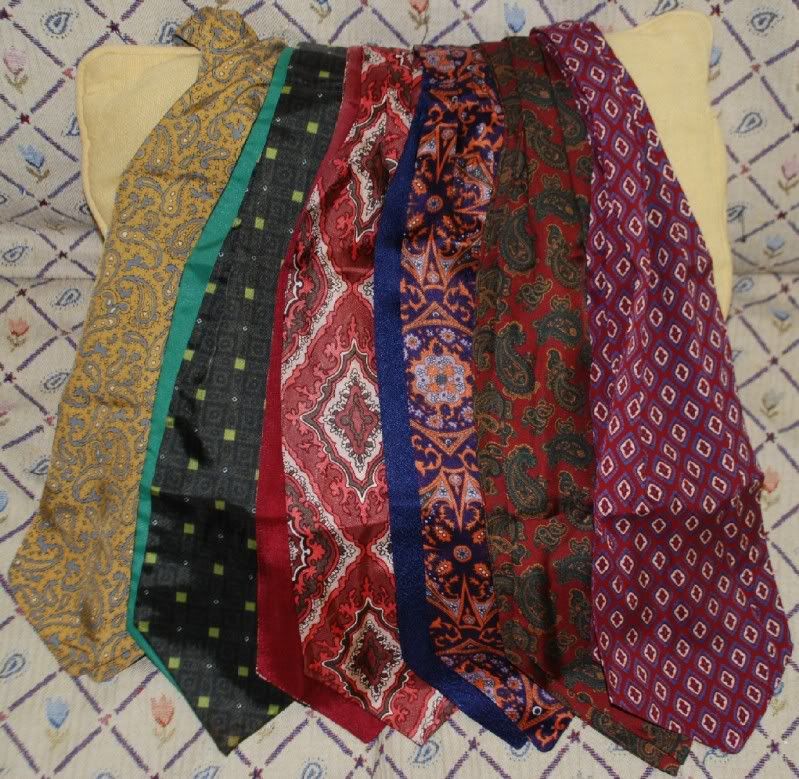Marcus
A-List Customer
- Messages
- 411
- Location
- Fallbrook, CA...Near Camp Pendleton
If it does taper (don't have it in front of me), it's not very much. Could it be a bow tie?




Spitfire said:Really dashing, Topedo!!!!:eusa_clap :eusa_clap
Torpedo said:Not one to make any idle threats, today I am already sporting one of the above collection...



Torpedo said:Hello,
I have decided to try cravats, or ascots as they are known too. I have got a brace of them, all vintage 60's, some classic patterns, some more daring:

1. No label, acetate
2. Grosvenor range by Tootal, acetate
3. No label, acetate (?)
4. Grosvenor range from Tootal, acetate.
5. No label, silk
6. Tootal, acetate
The first is banner-cut, (straight without shaping), the others shaped and pleated. 2, 3 and 4 would be reversible.
I will let you know when I actually start to wear them!
Evan Everhart said:The term "cravat" is applied to the thing itself and is derived from "Croat" as originally, the things were seen worn by Croatian mercenaries when they had marched into France after a victorious campaign in which they were employed by the French monarchy. This was some time in the mid to late 1600s if I recall correctly. The French admired their nifty neck-wear so much that they began to emulate them.
This explains the neck-wear itself only; it was originally a square of silk or lace which was folded on the diagonal with the opposing points meeting in the middle at the middle edge where one would fold an edge to form a triangle. after the initial two points are folded and meet, narrow folds are folded along that same initial fold until one has numerous voluminous folds that look like to trapezoidal figures meeting along a line; wide bottom to wide bottom, then one takes this folded piece of fabric with the line showing outside and wraps it about the neck and folds it in any number of ways.
The cravat is only known as an Ascot when one folds it in a square knot in such a manner that the center of the knot is smooth and square. This is then often pinned through with a stick pin that has a cap for the edge so as to avoid the pin poking one's jugular. The pin is usually worn at either a diagonal or horizontally. This is the same style of neck-wear that equestrians wear for formal fox hunting, dressage, and various other forms of formal equitation. Good show then. Enjoy!
By the by, the Ascot should really be worn with a stand up collar. I wear it on occasion with an open collar when casually riding, but when I doing so, I usually do not wear a stick pin. Furthermore, when wearing an Ascot and stand up collar, I always wear a waist-coat as well. It's the height of fashion as they say...Later then!
 Alden 403 Moc Toe Boot - Brown Chromexcel - $680 The classic "Indy" style Alden Boot in the classic Horween brown Chromexcel.
Alden 403 Moc Toe Boot - Brown Chromexcel - $680 The classic "Indy" style Alden Boot in the classic Horween brown Chromexcel.  Grant Stone Diesel Boot Dark Olive Chromexcel - #395 Goodyear welted, Horween Chromexcel, classic good looks.
Grant Stone Diesel Boot Dark Olive Chromexcel - #395 Goodyear welted, Horween Chromexcel, classic good looks.  Himel Bros. - The Ross Mk. 1 Leather Jacket Classic D-pocket motorcycle/aviator style jacket.
Himel Bros. - The Ross Mk. 1 Leather Jacket Classic D-pocket motorcycle/aviator style jacket. grantway said:Agree that the weight of the material helps in retaining the knot. A button down collar also helps stops the ascot /cravat from slipping down.
Alexi said:psst. croat was a common term for light calvary (aka hussar) that dressed in the "Croatian" style, even the Scots fielded "croats" in the Bishops and Civil Wars. The croats that the term cravat came from were probably just frenchmen dressed up funny.
grantway said:Agree that the weight of the material helps in retaining the knot. A button down collar also helps stops the ascot /cravat from slipping down. I prefer heavier silk ascots; I also have a couple of large silk squares that look good. I think this form of neckwear is having a bit of a comback as I have noticed more of them in advertisements and few younger guys in Sydney wearing. People give give me comlpiments when I wear mine.
Lionheart said:Agreed - but I also wear ascots with regular spread collars. It does tend to take more patience to keep the ascot from slipping with a spread, though. Especially if you wear your spread collars on top of your sportcoat lapels.